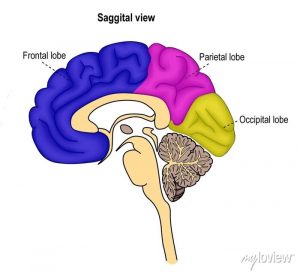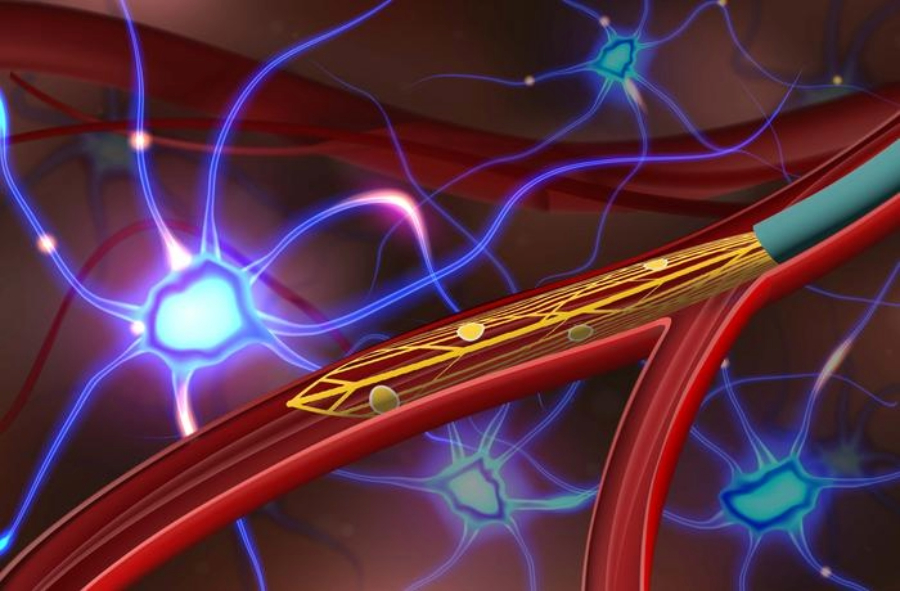Integration of wireless data transmission in Endovascular probe
The brain lies in a bony shell surrounded by protective fluids. The humanity and the outstanding quality possessed by human beings are provided by the nerve cells in the brain. The human brain is an exceedingly complex and significant organ accountable for fundamental functions such as thought, memory, emotions, feelings of hunger, and so on. The adult human brain weighs 1.4 kilograms. The three sections of the brain are the forebrain, midbrain, and hindbrain. The largest and most prominently built-up portion of the human brain is the forebrain. The intellectual activities of human beings are controlled by the cerebrum.

Figure 1: Human Brain
Image Source:https://myloview.com/poster-the-saggital-view-of-cortex-and-surface-anatomy-of-human-s-brain-no-C8AF890
Neuron and Neurotransmitter
The well-designed unit of the brain is neurons. The human brain consists of 86 billion neurons. The neurons generate nerve signals which are responsible for all sensations, movements, and thoughts. The three main parts of neurons are the cell body, dendrites, and axon. The insulation for axons is provided by Myelin a fatty molecule. With the help of Myelin, the nerve signals travel predominantly at a faster rate.
The brain cells communicate with each other using Neurotransmitters. Neurotransmitters are of two types excitatory and inhibitory. Excitatory neurotransmitters make cells more active and Inhibitory neurotransmitters diminish the activity of a cell.
Acetylcholine:
It is an excitatory neurotransmitter. It governs muscle contractions and hormone secretion by various glands. The lack of acetylcholine in the human body leads to Alzheimer’s disease, which is the initial stage that deteriorates memory formation.
- Glutamate:
It is a major excitatory neurotransmitter. Excess of glutamate in the human body can destroy and damage neurons. It results in lifelong disorders such as Parkinson’s disease, stroke, seizures, and enlarged compassion for pain.
- GABA (Gamma-aminobutyric acid):
It is an inhibitory neurotransmitter that coordinates the functioning of muscles. It plays an important role in issues related to ophthalmology. Drug inhibition increases GABA levels in the brain. The various tremors in patients can be treated by increased GABA levels.
- Serotonin:
It is a neurotransmitter that stimulates sleep and regulates body temperature. When serotonin level decreases humans suffer from sleep problems and depression,
- Dopamine:
Dopamine is responsible for mood swings in human beings. This hormone is capable of making humans increasingly irritable at certain times without any reason. Parkinson’s disease is also correlated to dopamine content.
Monitoring brain activity:
In the field of medicine, neuroscience, and research monitoring brain activity has become a hard-to-believe area. The vital reasons for monitoring brain activities are diagnosing and treating various neurological disorders, monitoring brain health, and BCI (Brain Computer Interface) for establishing nonstop communication between the human brain and peripheral devices.
What are endovascular probes?
In the field of interventional cardiology and neurology Endovascular probes are dedicated medical devices that perform vital functions. The Endovascular probes can be inserted into blood vessels involving minute invasive procedures to contact and treat neurological conditions.
These probes allow for diagnosis, interventions, and therapeutic imaging. Miniaturized imaging equipment such as fluoroscopy, ultrasound, and angiography accompanies endovascular probes to visualize brain activity.
Sometimes electrical sensors are integrated with endovascular probes to measure parameters like pressure or flow of blood in blood vessels in the brain. The data acquired from the endovascular probes can be wirelessly monitored by the remote healthcare provider.
Brain-Computer Interface (BCI)
Quite a few researchers across the globe are contributing their time to research in the Brain-computer interface to pave the way to an absolute communication trail between brain and the external devices.
Individuals with bodily disabilities, such as spinal cord injuries, and amyotrophic lateral sclerosis (ALS) can easily communicate with the advent of BCI technology.
The usage of brain signals, such as electroencephalography (EEG), and electrocorticography (ECoG) is witnessed in BCI.
BCI can be broadly classified into Invasive BCIs and non-invasive BCIs.
Invasive BCI:
These are implanted directly into the brain and provide high precision but involve a surgical procedure
Non-invasive BCIs:
These do not require surgical implantation and include EEG-based BCIs that use electrodes on the scalp to detect brain activity. These combine multiple types of brain signals, such as EEG and electromyography (EMG), for improved accuracy and functionality. The brain signals acquired by BCI are analyzed, converted into digital signals by Analog to Digital converters, and are transmitted to output devices for undertaking necessary actions. The signal-acquisition circuit used in BCI has to be designed in such a way that it is convenient to use, transportable, not dangerous, and able to function under all circumstances.
The emerging field of brain-computer interface (BCI) is a boon to individuals unable to speak. The technology helps the differently abled to communicate and manage walking aids for walking.
This BCI has already revolutionized the daily life of a few physically challenged people across the globe. BCI control technology with its precise signal-accomplishment hardware, lucid scientific validation, and trustworthiness, may help people with disabilities and perhaps the broad-spectrum population also
Source:
- https://www.ninds.nih.gov/health-information/public-education/brain-basics/brain-basics-know-your-brain
- https://www.ninds.nih.gov/health-information/disorders/alzheimers-disease
- https://www.ninds.nih.gov/health-information/disorders/parkinsons-disease
- https://www.ninds.nih.gov/health-information/disorders/stroke
- https://my.clevelandclinic.org/health/articles/22513-neurotransmitters

